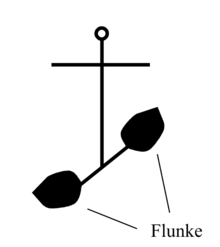fluke
A fluke is the shovel-shaped part of an anchor that digs into the ground with it.
Depending on the type, the anchor has one or more flukes. A stick anchor has two flukes, a ploughshare anchor one fluke and a folding anchor or folding dragging four to six flukes.
The area of the fluke buried in the ground and the angle at which the fluke is buried in the ground determine (in addition to the weight of the anchor) the holding force of the anchor:
- The larger the buried area of the fluke, the greater the mass of the soil that acts on the fluke, and the greater the resistance it opposes to displacement in the ground. A large buried area of the fluke means that the anchor has a large holding force.
- In the case of an anchor chain or anchor line that rests on the ground in the area of the anchor and thus acts on the anchor with a horizontal tensile force, a fluke buried vertically in the ground causes a high holding force of the anchor. However, as soon as the anchor chain or anchor line no longer engages horizontally on the anchor in higher winds , the holding force of the anchor is reduced if the fluke is vertically buried. As a result, the angle between fluke and ground should always be less than 90 ° in order to still be able to ensure sufficient holding force of the anchor even with greater wind strengths.
literature
- Ramon Gliewe (ed.): Seamanship . 26th edition. Delius Klasing Verlag, Bielefeld 2003, ISBN 3-7688-0523-9 , page 94.
- Overschmidt, Gliewe: sport boat license inland . Delius Klasing Verlag, Bielefeld 1992, ISBN 3-7688-0657-X , page 94.
- Joachim Schult: Sailors Lexicon . Delius Klasing Verlag, Bielefeld 2001, ISBN 3-7688-1041-0 , page 175.


